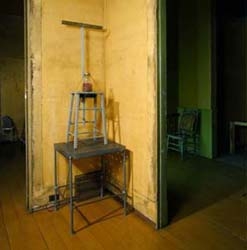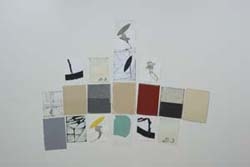
Untitled (2006), painted wood, painted cardboard, glass, metal, cement, framed photograph, nail clippings, plaster, wax, porcelain, 73 in. x 39 in. x 15-3/4 in.
Feature: Reviews
David Ireland
- Gallery Paule Anglim
- San Francisco, California
- October 5 - November 4, 2006
David Ireland has been a familiar figure in the West Coast art scene for three decades. Not focusing on a career in art until reaching his 40s, he spent his earlier years seeking out an array of experiences. After earning a B.A. in Industrial Design and Printmaking, Ireland lived in Asia, Europe and Africa. He pursued work in numerous professions, most notably serving as an African safari guide during the 1960s and early ‘70s. Soon after completing graduate work at the San Francisco Art Institute in 1974, he purchased a house at 500 Capp Street, in the city’s not-yet-gentrified Mission District. Ireland held onto much physical evidence of the building’s past inhabitants, including a T.V. set, brooms, and old flooring. While collecting these artifacts, some of which would eventually figure into sculptures and installations, Ireland began an ongoing process of both preserving and removing layers of history found in the walls and floors of the house.
Gallery Paule Anglim is presenting Ireland’s first solo show since his major retrospective, 2003’s The Way Things Are, a traveling exhibit that opened at the Oakland Museum. In some ways, the Anglim show feels like a less ambitious follow-up to the retrospective. Penn’s Pocket (1992), which also made an appearance in The Way Things Are, is an installation that references photographer Irving Penn’s method of posing subjects in a potentially phobia-inducing corner. Off to one side of the gallery, Ireland has put up two walls that meet to form a V-shaped space identical to the one that Penn used. Underneath glass, a print of Penn’s Marcel Duchamp portrait is set back into one wall. In order to view the photo, one must stand in the same cramped environment that Duchamp is seen in. It’s an example of a winking humor that Ireland often employs.
Rubber Band Collection with Sound Accompaniment (1977) incorporates a simple, grey wooden stool. A jar filled with rubber bands sits atop the stool, while a cassette player is mounted underneath the seat. Dangling earphones allow the participant to hear daily recordings of Ireland removing rubber bands from newspapers. The rubber bands are items that Ireland has collected in the Capp Street house, although this time they are, essentially, his own. After instigating the process of collecting what previous owners of the house had left behind, Ireland began organizing things accumulated during his own daily life.
Untitled (2006) brings together numerous small pieces placed on the shelves of an old cabinet. It’s hard not to think again of Duchamp, whose Box in a Valise was composed of past works, in the form of small reproductions. Ireland’s cabinet, his only new creation in the show, holds original works — a figure encased in concrete, a sculpture with an ear/Africa shape — that feature motifs he has returned to over the years.
In a smaller room near the main gallery space, forty-two untitled and undated works on paper are hung on the four walls. Coming from Ireland’s personal collection, no single piece measures more than 1-1/2 feet across. Some are covered in a mostly uniform yellow or white, showing evidence of mark making only around the fringes. Others include splotches of concrete and spray paint. Several black and white works featuring geometric shapes are surprisingly similar to the Ocean Park paintings of Richard Diebenkorn, a considerably more conventional artist.
The Anglim show essentially offers a look back on Ireland’s career. Sadly, health issues have interfered with his recent artistic production. One hopes that, in the near future, there will be more new work to see.


